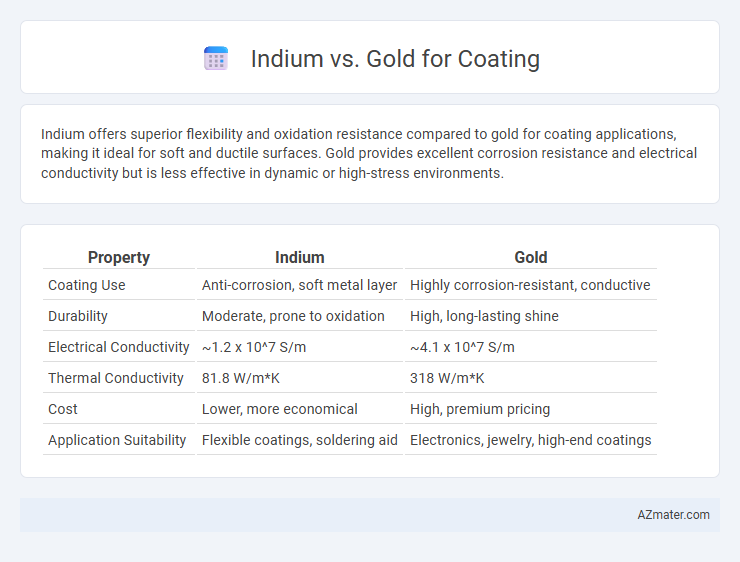Indium offers superior flexibility and oxidation resistance compared to gold for coating applications, making it ideal for soft and ductile surfaces. Gold provides excellent corrosion resistance and electrical conductivity but is less effective in dynamic or high-stress environments.
Table of Comparison
| Property | Indium | Gold |
|---|---|---|
| Coating Use | Anti-corrosion, soft metal layer | Highly corrosion-resistant, conductive |
| Durability | Moderate, prone to oxidation | High, long-lasting shine |
| Electrical Conductivity | ~1.2 x 10^7 S/m | ~4.1 x 10^7 S/m |
| Thermal Conductivity | 81.8 W/m*K | 318 W/m*K |
| Cost | Lower, more economical | High, premium pricing |
| Application Suitability | Flexible coatings, soldering aid | Electronics, jewelry, high-end coatings |
Introduction: Overview of Indium and Gold Coatings
Indium and gold coatings are widely used in electronics and industrial applications for their unique conductive and protective properties. Gold coatings offer superior corrosion resistance and excellent electrical conductivity, making them ideal for high-reliability contacts and connectors. Indium coatings provide a softer, more malleable surface with strong adhesion, often used in thermal interface materials and applications requiring good solderability and oxidation resistance.
Material Properties: Indium vs Gold
Indium exhibits excellent malleability and low melting point of 156.6degC, making it ideal for creating flexible, soft coatings that maintain electrical conductivity under stress. Gold boasts superior corrosion resistance, high thermal stability above 1,064degC, and excellent electrical conductivity, ensuring durable and reliable coating performance in harsh environments. Indium's atomic structure allows better adhesion to substrates like glass and semiconductor materials, while gold's dense atomic lattice provides exceptional resistance to oxidation and wear.
Coating Techniques and Applications
Indium offers superior adhesion and softness compared to gold, making it ideal for delicate electronic coatings and thermal interface materials. Gold's excellent corrosion resistance and high electrical conductivity suit it for plating connectors, switches, and high-reliability electrical contacts. Physical vapor deposition (PVD) and electroplating are common techniques for gold, while indium coatings often use thermal evaporation and sputtering to achieve uniform thin films for advanced semiconductor and sensor applications.
Adhesion and Surface Compatibility
Indium offers superior adhesion to substrates with high thermal expansion coefficients compared to gold, making it ideal for applications requiring stress compliance and durability. Gold provides excellent surface compatibility due to its chemical inertness and resistance to oxidation, ensuring stable electrical conductivity and corrosion resistance. While gold forms reliable, uniform coatings on a wide range of materials, indium's malleability enhances mechanical bonding on uneven or rough surfaces.
Electrical Conductivity Comparison
Indium offers moderate electrical conductivity of approximately 3.3 x 10^6 S/m, while gold provides superior conductivity around 4.1 x 10^7 S/m, making gold significantly more efficient for electrical applications. Gold's excellent conductivity, combined with its high resistance to oxidation and corrosion, ensures stable and reliable electrical contact over time. Indium coatings are often selected for their malleability and solderability but are less effective where maximum conductivity is critical.
Optical Performance and Reflectivity
Indium coatings exhibit excellent infrared reflectivity and high transmission in the visible spectrum, making them suitable for specialized optical applications requiring selective wavelength management. Gold coatings provide superior reflectivity across a broad range of wavelengths, especially in the infrared and near-infrared regions, enhancing performance in optical devices like sensors and mirrors. The choice between indium and gold depends on desired spectral reflectance characteristics and environmental durability for specific optical systems.
Durability and Corrosion Resistance
Indium coatings exhibit excellent corrosion resistance, maintaining stability in harsh chemical environments and resisting tarnish better than many metals, including gold. Gold coatings, prized for their inertness and resistance to oxidation, provide superior long-term durability in electronic and decorative applications. While gold offers consistent corrosion resistance, indium's ability to form strong oxide layers enhances its durability in specialized industrial settings where chemical exposure is significant.
Cost Analysis: Indium vs Gold
Indium offers a cost-effective alternative to gold for coating applications due to its significantly lower market price, averaging around $200 per kilogram compared to gold's approximate $60,000 per kilogram. Despite gold's superior conductivity and corrosion resistance, indium provides adequate performance in less demanding environments at a fraction of the cost. Industries seeking budget-sensitive solutions often favor indium coatings to balance cost efficiency with functional durability.
Environmental and Sustainability Considerations
Indium coatings offer a lower environmental impact due to their lower toxicity and better recyclability compared to gold, which is often associated with environmentally harmful mining practices and high energy consumption. Indium's abundant availability reduces resource depletion concerns, while gold mining generates significant ecological disruption and carbon emissions. Choosing indium over gold for coatings supports sustainable material sourcing and reduces the overall environmental footprint of electronic and industrial applications.
Choosing the Right Coating: Key Takeaways
Indium offers superior softness and malleability, making it ideal for applications requiring excellent thermal and electrical conductivity with minimal contact resistance. Gold provides exceptional corrosion resistance and long-term durability, preferred in harsh environments and electronic connectors where reliability is critical. Choosing between indium and gold coatings depends on factors like mechanical stress tolerance, environmental conditions, and cost-effectiveness for specific electronic or thermal interface applications.

Infographic: Indium vs Gold for Coating
 azmater.com
azmater.com